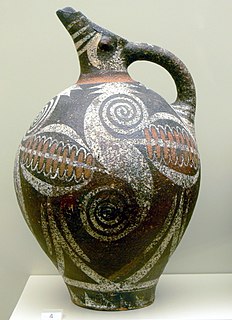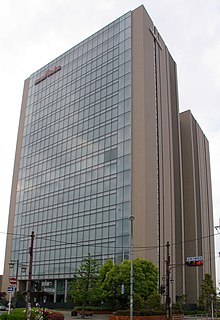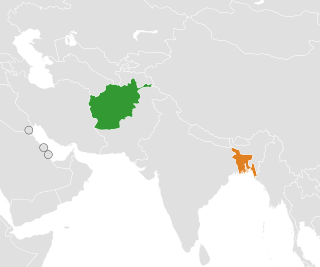Related Research Articles

A ceramic is a solid material comprising an inorganic compound of metal or metalloid and non-metal with ionic or covalent bonds. Common examples are earthenware, porcelain, and brick.

The Alfred Ceramic Art Museum at Alfred University in Alfred, New York, United States houses nearly 8,000 ceramic and glass objects by internationally known ceramic artists. While originally housed in 1,500 sq. ft. of exhibition space in the New York State College of Ceramics' Binns-Merrill Hall, the museum's new building was constructed in 2010 by KMW Architects to allow the museum to grow since the village of Alfred is known as a ceramics mecca.

Murata Manufacturing Co., Ltd. is a Japanese manufacturer of electronic components, based in Nagaokakyo, Kyoto.

Höhr-Grenzhausen is a town in the Westerwaldkreis in Rhineland-Palatinate, Germany. It is a centre for the ceramic industry in the Kannenbäckerland with a professional college for ceramics, another for ceramic form, and many others, hence the nickname Kannenbäckerstadt.

Ceramic glaze is an impervious layer or coating of a vitreous substance which has been fused to a ceramic body through firing. Glaze can serve to color, decorate or waterproof an item. Glazing renders earthenware vessels suitable for holding liquids, sealing the inherent porosity of unglazed biscuit earthenware. It also gives a tougher surface. Glaze is also used on stoneware and porcelain. In addition to their functionality, glazes can form a variety of surface finishes, including degrees of glossy or matte finish and color. Glazes may also enhance the underlying design or texture either unmodified or inscribed, carved or painted.

The George R. Gardiner Museum of Ceramic Art is a ceramics museum in Toronto, Ontario, Canada. The museum is situated within University of Toronto's St. George campus, in downtown Toronto. The 4,299.2-square-metre (46,276 sq ft) museum building was designed by Keith Wagland, with further expansions and renovations done by KPMB Architects.

Sèvres – Cité de la céramique is a French national ceramics museum located at the Place de la Manufacture, Sèvres, Hauts-de-Seine, a suburb of Paris, France. It was created in January 2010, from the merger of the Musée national de Céramique-Sèvres and the Manufacture nationale de Sèvres. The museum is open daily except Tuesday; an admission fee is charged. Access to the museum by public transportation is available from Tramway d'Île-de-France station Musée de Sèvres on Tramway T2, and by Paris Métro station Pont de Sèvres on Line 9.

CoorsTek, Inc. is a privately owned manufacturer of technical ceramics for aerospace, automotive, chemical, electronics, medical, metallurgical, oil and gas, semiconductor and many other industries. CoorsTek headquarters and primary factories are located in Golden, Colorado, USA, near the foothills west of Denver. The company is wholly owned by Keystone Holdings LLC, a trust of the Coors family. John K. Coors, a great-grandson of founder and brewing magnate Adolph Coors, Sr., and the fifth and youngest son of longtime chairman and president Joseph Coors, retired as president and chairman in January 2020 after 22 years at the helm.

Claude Horan was an American ceramic and glass artist who was born in Long Beach, California. He received a BA from San Jose State University in 1942 and an MA degree in art from Ohio State University in 1946. His wife Suzi Pleyte Horan collaborated on many of the larger projects. He was a lifeguard and longboard surfer in Santa Cruz in the late 1930s, and is credited with naming Steamer Lane.
RAK Ceramics P.J.S.C is one of the largest ceramics brands in the world. Headquartered in the emirate of Ras Al Khaimah in the United Arab Emirates, RAK Ceramics has an annual production capacity of 110 million square metres of tiles, 5 million pieces of sanitaryware, 24 million pieces of porcelain tableware and 600,000 pieces of faucets. The company employs 15,000 people across its operations in the UAE, India, Bangladesh, Iran, Europe, Australia and Singapore.

Gladding, McBean is a ceramics company located in Lincoln, California. It is one of the oldest companies in California, a pioneer in ceramics technology, and a company which has "contributed immeasurably" to the state's industrialization. During the heyday of architectural terra cotta, the company "dominated the industry in California and the Far West."
Lucideon is an independent materials development, testing and assurance company based in Stoke-on-Trent and in the US. Lucideon owns testing facilities around the world.

Argentina–Bangladesh relations refer to the bilateral relations between Argentina and Bangladesh.

Afghanistan–Bangladesh relations refer to the bilateral relations between Bangladesh and Afghanistan.
Shinepukur Ceramics is a ceramic manufacturing company based in Dhaka, Bangladesh.
The ceramics industry is a growing manufacturing sector in Bangladesh. The industry started during the late 1950s when the first ceramic industrial plants were established. The industry mainly produces tableware, sanitaryware and tiles. As of 2011, there were 21 ceramic industrial units throughout Bangladesh, employing about 500,000 people. In the first nine months of the 2013-14 fiscal year, Bangladesh exported about US$36 million worth of goods after meeting 80% of the domestic demand. The main export destinations are the EU, the US and the Middle- ast.

Ceramic art is art made from ceramic materials, including clay. It may take forms including artistic pottery, including tableware, tiles, figurines and other sculpture. As one of the plastic arts, ceramic art is one of the visual arts. While some ceramics are considered fine art, as pottery or sculpture, most are considered to be decorative, industrial or applied art objects. Ceramics may also be considered artefacts in archaeology. Ceramic art can be made by one person or by a group of people. In a pottery or ceramic factory, a group of people design, manufacture and decorate the art ware. Products from a pottery are sometimes referred to as "art pottery". In a one-person pottery studio, ceramists or potters produce studio pottery.

Harunur Rashid Khan Monno was a Bangladeshi industrialist and politician. He served as the chairman of his conglomerate, Monno Group of Industries. He was elected a member of parliament and a minister of the Government of Bangladesh. He was also an adviser to Bangladesh National Party Chairperson Khaleda Zia.

Bangladesh Institute of Glass and Ceramics (BIGC) is the oldest and only institute of its kind in Bangladesh. The establishment of the institute dates back to 11 March 1951 named as “East Bengal Ceramics Institute”. In 1960 the institute was renamed “East Pakistan Institute of Glass and Ceramics (EPIGC)”. In 1971 Bangladesh emerged as an independent nation from Pakistan, the institute was again renamed as “Bangladesh Institute of Glass and Ceramics” in 1972. With the growing demands of Glass and Ceramics sector of mid-level technical manpower home and abroad 3(three) years Diploma in Ceramic Engineering was introduced in the year 1978 and Diploma in Glass Engineering was introduced in the year 2000. Duration of the Glass and Ceramic Engineering Course has changed to 4(four) years from the year 2000.
Manikganj-2 is a constituency represented in the Jatiya Sangsad of Bangladesh since 2014 by Momtaz Begum of the Awami League.
References
- ↑ "Ceramics- A daily essential". New Age. Archived from the original on 13 June 2014. Retrieved 13 June 2014.
- ↑ "not just your average cup of tea!". The Daily Star. Retrieved 13 June 2014.
- ↑ "Ceramics: where to go for what you need". The Daily Star. Retrieved 13 June 2014.
| This Bangladesh-related article is a stub. You can help Wikipedia by expanding it. |
| This article related to a manufacturing company is a stub. You can help Wikipedia by expanding it. |